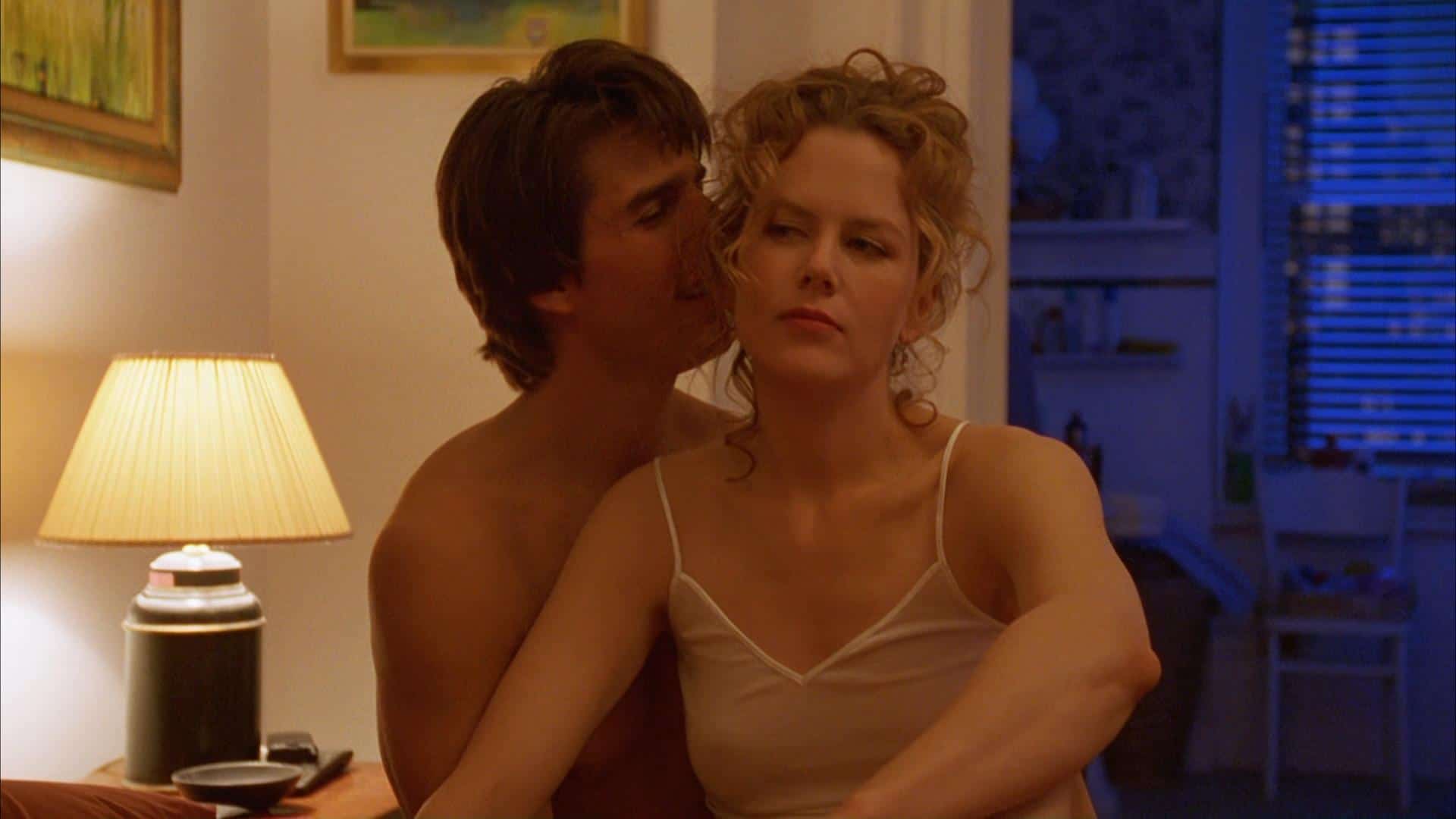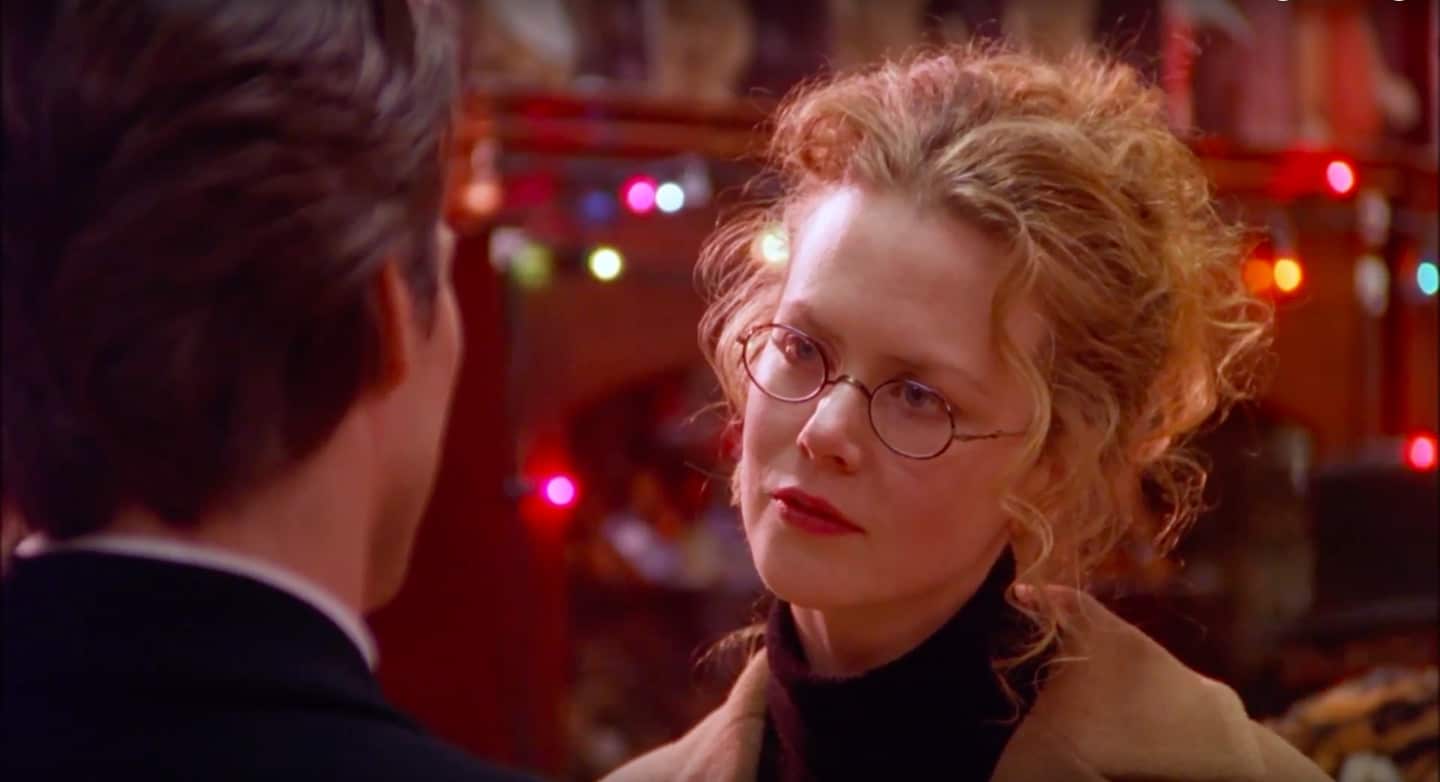
This article is part of our One Perfect Archive project, a series of deep dives that explore the filmmaking craft behind some of our favorite shots. In this entry, Brad Gullickson looks back at Stanley Kubrick’s Eyes Wide Shut.
This week, I celebrate my 10th year of marriage to Lisa Gullickson. All my life, I was told that “love don’t come easy” and “marriage takes work.” There’s no such thing as the perfect partner. Love is a lifetime of compromise, commitment, sacrifice, and responsibility. Contemplate that before “I do” leaves your lips. Ok, thanks to the infinite self-help section of Barnes & Noble. Honestly, though, I can say that life with Lisa has been a breeze, and whatever laborious blather the Joel Osteens and Phil McGraws of this world have conjured into financial empires does not apply to us. We got this. We’ve seen Eyes Wide Shut. That’s all we needed.
Open communication is key. Sure. That cliche is true. Don’t bottle up your fantasies. Certainly, don’t weaponize them against each other. Don’t armor your jealousy with proximity explosives loaded with all your wildest erotic wants. Detonate those incendiary devices at the jump, pre-marriage, before they erupt and ruin everything years later. Absorb the final word of this film and let it guide you till you’re both old and gray.
So much of the conversation regarding Eyes Wide Shut revolves either around its placement in the filmography of Stanely Kubrick, the digital tampering of the orgy showcase to lower its rating from NC-17 to a more profitable and puritanically palatable R, or the strain the production placed on the real-life marriage between stars Tom Cruise and Nicole Kidman. Understandable. These elements make for significant study and gossip. I’ve spent many nights considering the bedroom conversations of its stars before, during, and after filming.
For as stern a taskmaster as his reputation brands him, Kubrick was as much an imp silently giggling behind his viewfinder while he composed sequences to strain their relationship for the betterment of his movie. That’s a definite allure for the film fanatic, or at least our basest elements. The reality behind the fiction of Eyes Wide Shut adds an extra layer of voyeurism that it will never escape, and it’s hard not to imagine the genuine turmoil sparked in Cruise and Kidman’s relationship by this film when they eventually broke up two years later.
Outside of the institution of marriage, monogamy appears like a symptom of madness. Decades-long unions are the creation of religion more than the heart, right? Tell that to the beavers, gibbons, penguins, and swans of this world. Surely, we can lock it down like these betrothed beasts. Teenage Brad would have cynically fired shots across love’s bow by damning it a Hallmark fabrication designed to separate rubes from their cash. Then, in 1999, I sat down in a theater to watch the final work of Stanley Kubrick, and I discovered the real drudgery demanded by devotion.
Eyes Wide Shut was one of many projects Kubrick contemplated as he wrapped 2001: A Space Odyssey. Based on the novel Dream Story by Arthur Schnitzler, the original narrative was centered in Vienna at the turn of the century. Set during the celebration of Carnival, the basic premise of sexual fantasies corrupting the image of their partners remains intact in the film as does the masquerade aesthetic. While he toiled over the adaptation through the years, the concept of Eyes Wide Shut altered tones and actors many times. Initially, Kubrick saw Woody Allen in the role of the husband, but as the ’70s took hold the film slipped into possible slapstick with Steve Martin circling the script.
The project sank deeper into Kubrick’s desk drawer, and other films came and went. By the early 1990s, Kubrick brought on screenwriter Frederic Raphael (Far From the Madding Crowd, Two for the Road) to update the era of the novel from the early 1900s to modern day and replace Vienna with New York City. With that established, Kubrick then turned to his buddy Michael Herr (Full Metal Jacket, Apocalypse Now) for a polish, but the screenwriter rejected the offer over concerns of payment and the idea of committing towards another epic Kubrickian production. Naturally, as he did on almost all of his movies, Kubrick completed his own tinkering on the screenplay.
Harvey Keitel and Jenifer Jason Leigh were cast in the roles of Bill and Alice Harford, and Kubrick even shot full sequences with them, but since Kubrick’s process is that of a snail, the actors dropped out over scheduling conflicts with Finding Graceland and eXistenZ, respectively. Warner Bros. was chomping at the bit for Kubrick to work with a “name actor” again, The Shining‘s Jack Nicholson being his last marquee star. Tom Cruise was in the process of elevating his status beyond his sprint and smile. While Kidman was filming The Portrait of a Lady in England, the married couple invaded Kubrick’s estate and walked away with the roles.
Filming began in November of 1996 and didn’t end till nearly two years later. Kubrick’s fear of flying kept him grounded in England, forcing New York City to be constructed on the stages of Pinewood Studios. The result is an out-of-touch classical effect that contributes to the film’s dreamlike state in which Bill Harford stumbles.
As he delighted in doing, Kubrick promoted his gaffer on Barry Lyndon and The Shining, Larry Smith, to cinematographer. He demanded that Smith use available light sources on set and on location, refusing the typical studio equipment. Chandeliers and Christmas tree lights may produce more light than candlesticks but not much more. Smith decorated scenes with Chinese paper ball lamps and crossed his fingers that push-processing the celluloid would boost the color. Again, such choices enhance the otherworldliness of the protagonist’s point of view.

None of this, of course, was on my mind when I first saw the film in 1999. I barely had an understanding of Kubrick as a director at that point. I had seen The Shining, Full Metal Jacket, and Dr. Strangelove. They were movies I recognized as art and important to college film students, but they did not latch to my definition of self. I was barely an adult. Marriage = dumb. Single life, ride, or die. Also, if I am to be 100 percent honest, I pretty much bought my ticket as a result of the hubbub around the rating. It’s the Showgirls consumer effect. Boobs — there were going to be a lot of them.
Eyes Wide Shut threw me off my game immediately. The film lulls you into this ultra dull Christmas party where Bill and Alice force their way through the monotony of small-talk. Bill runs into an old medical school buddy hustling as a lounge act for the rich muckety-muck throwing the shindig. Alice flirts with a much older man on the make, and Bill loses himself in the fawning of two models on his arm. The schmoozing and exchanging of pleasantries cease when Bill is called upstairs to tend to a naked woman who has overdosed in the host’s bedroom.
Back home, Bill and Alice find relaxation in a shared joint. Their conversation quickly drifts to their playful dalliances. Bill attempts to blow it off by explaining that he never worried about Alice’s party prowl because women are instinctively monogamous. Ruffled, Alice launches into an elaborate description of the fantasies sparked within when she caught the gaze of a random naval officer during their family vacation to Cape Cod. The film enters her mind, and we bear witness to their human entanglement, and we cut back to Bill’s face breaking.
To achieve that expression on Cruise, Kubrick barred the actor from the set as he filmed the theoretical sex scene for six days. Legend says that Kidman and Gary Goba posed in over 50 positions during that week of shooting and that Kubrick ordered that Kidman not reveal any details to her husband during that time. Contemplate the inner smile stretched across the director’s brain (Kubrick certainly wouldn’t expose it on his face) as he massaged genuine hurt through simulation. When reports surfaced saying just as much, Cruise rapidly retorted that he and Kidman were in love with their creative overlord. You do what you gotta do to capture the perfect frame.
Twenty minutes in, no orgies, but the trauma of unloading fantasies upon one another burns on the screen. Bill cannot handle his wife’s revelation, and his perceived inadequacy as a lover melts his brain. He doesn’t have time to explode into rage or tears because he’s called to meet a patient who has perished in the night. The dead man’s daughter, caught with grief, tries to seduce Bill mere feet from papa’s corpse. He gets the hell out of there, but he can’t go home. He wanders the sets of Pinewood, engages and disengages with a prostitute before any action can be committed, and bumps into his lounge singer pal at a jazz club. His buddy strives to cheer Bill up by inviting him to an exclusive gathering devoted to sexual release complete with masquerade masks and multiple passwords. An orgy, hell yeah.
Dammit. Bill is presented with the perfect opportunity to out-fantasy Alice. He grabs a taxi to the location described by his friend. He’s the only guest to do so and instantly sticks out as an interloper. Inside, he witnesses every desire. Yes, it’s overwhelming. One masked woman warns him that he’s in terrible danger and before he can partake in any activity he’s called into a large conference room where masked dynamos surround him.
Exposed as a trespasser, the orgy master lets him off with a warning and Bill returns to his home. Guilt and shame swirl within but confusion jumbles his brain. What does he do with the information Alice unloaded on him? What did he witness back at that mansion? Was it sinister or just another party beyond his understanding? He digs into their mystery, trips upon the corpse of the masked woman, but ultimately ends his investigation with no additional knowledge. He’s utterly empty. He’s a chump.

Eyes Wide Shut concludes with Alice uncovering Bill’s exploits and, finally, Bill discharging his anger and bewilderment. With all their desire and doubt unveiled before each other, the married couple can fall back into the routine of a relationship. There is Christmas shopping to attend; their child’s wishes need to be fulfilled. Bill wants to know what to do, and Alice only has one word for them: “Fuck.”
What went on at the mansion doesn’t matter. What went on inside Alice’s head doesn’t matter. They’ve survived adventures both real and imaginary. That has to count for something. It’s like the beaches of Dunkirk. “Survival is victory.” Awoken from their fantasies, Bill and Alice reconnect, and they have a fuller understanding of the person in their bed.
In 1999, their final meeting rocked me. I was a kid. Single. Alone. Peeling your brain back and baring much-guarded thoughts was terrifying, but Kubrick presented a damn fine argument to do just that. I never imagined that I would meet a person worth such honesty. Then came Lisa and truth didn’t seem so hard. It became necessary and enjoyable.
Forever is a scary word, and like Alice, it’s one that we don’t throw around lightly. However, if you have any chance of lasting longer than an argument or two, you realize all your doors have to be made open for the other. If you find a locked one inside, then you need to address the reason behind that bolt sooner rather than later. Someone is going to come rattling, and when it inevitably breaks, humiliation will be the least of your problems.
Related Topics: Eyes Wide Shut, Nicole Kidman, One Perfect Archive, Stanley Kubrick, Tom Cruise

